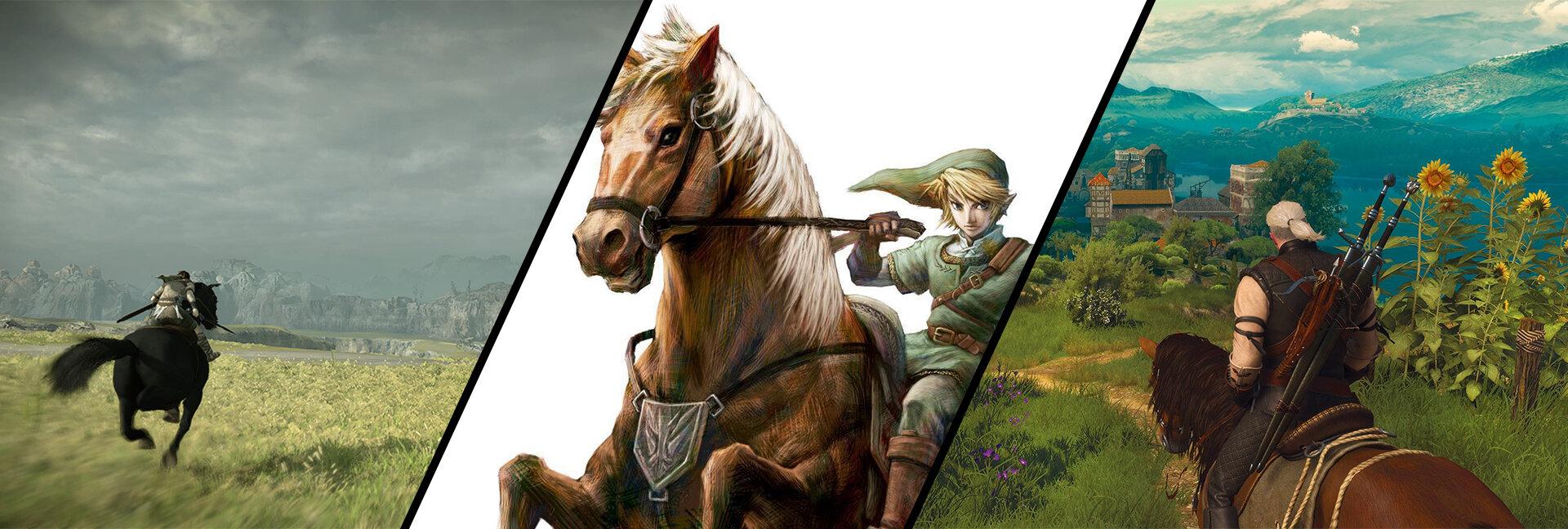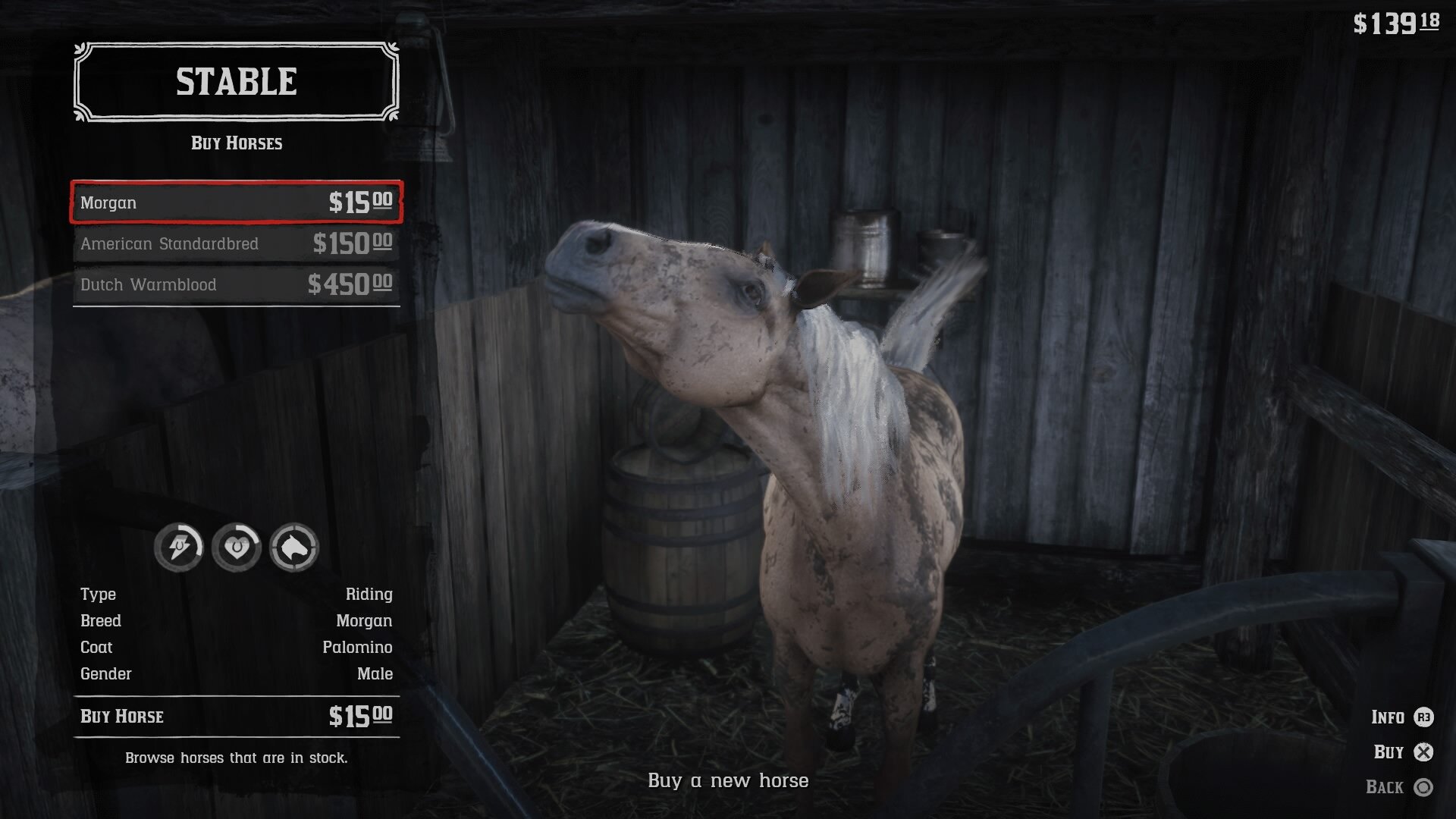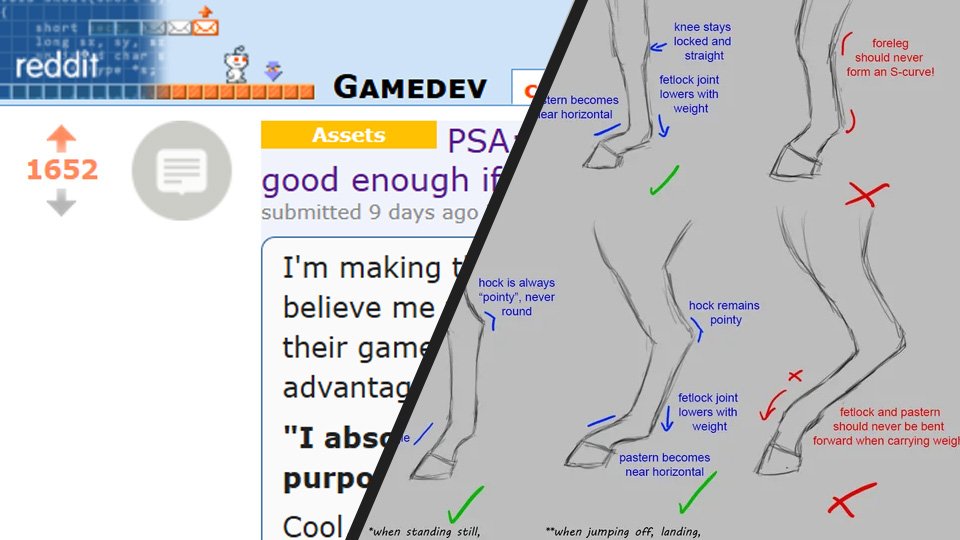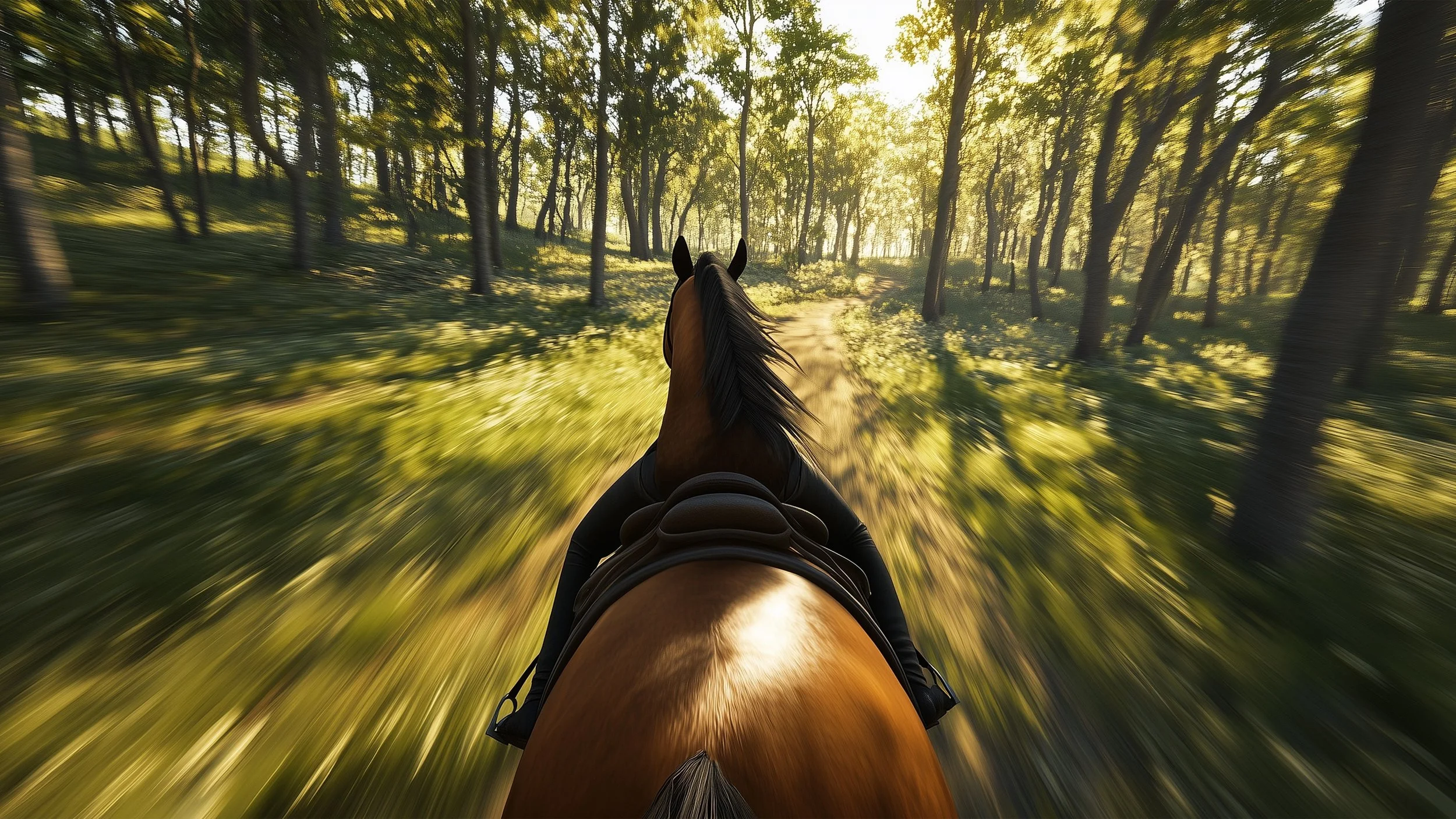Horses in Games: Companions and Collectibles
Outside of the genre of ‘horse games’, there are plenty of games which have one or multiple horses as a secondary feature. The horses in games like The Witcher, The Legend of Zelda, Assassin’s Creed or Red Dead Redemption have varying depths of gameplay and serve purposes such as being a means of transport, an important Non-Playable Character or one of many collectible items. Broadly speaking, most implementations of horses in video games fit into one of two categories: Companion Horses and Collectible Horses. Companion horses are NPCs of varying importance, they probably have a defined coat color and name, and they stay with you throughout the game. A game with collectible horses on the other hand may let the player buy or catch a multitude of horses with different stats, looks and probably player-given names.
Let’s have a look at examples of both categories, why people might prefer one or the other, and what developers may have to consider when deciding on one of them for their game.
Companions: Equine Friends
Epona
Please note that this section of the article contains mild spoilers for The Legend of Zelda: Twilight Princess. Proceed at your own risk.
Link and Epona, finally reunited in Kakariko Village in Twilight Princess.
For those who have grown up playing the Legend of Zelda series, the prime example of a companion horse will likely be Epona, trusted mount of the Hero of Time. Epona debuted in 1998’s The Legend of Zelda: Ocarina of Time, where the player first encounters her as a foal at Lon Lon Ranch. One can return there at a later time (literally) to ride away on the now grown mare. While Epona is also available and briefly important in 2000’s Majora’s Mask, her proper return as a full NPC is in the 2005 Zelda game Twilight Princess, which is where I first encountered her — and fell in love.
In Twilight Princess, Epona makes a first appearance in Link’s quiet home of Ordon Village and is shortly thereafter stolen by Bulblins. On my first journey across Hyrule Field on foot, it felt like something was distinctly missing, between the vast space and the grand music. Once you get your horse back however, travelling across the same grassy hills becomes a pure joy. To teenage me, this wonderful freedom, this triumph of having my beloved mount back and cantering onwards to the great adventure under the beautiful music was an utterly magical moment. It was my favorite implementation of horse companions in games long before I was able to fully articulate what that meant.
Like the player character himself, the horse can be renamed in Twilight Princess, but just as everyone knows that the green-clad swordfighter’s name is Link, the horse has a firmly canonical name in Epona, a reference to the celtic goddess of horses and fertility.
Agro
Please note that this section of the article contains major spoilers for Shadow of the Colossus. Proceed at your own risk.
Her animations may be wobbly, but we love her.
2005 cult classic Shadow of the Colossus lives off its sense of isolation: Main character Wander is alone in the world aside from the large stone and grass colossi that he sets out to slay. Alone, that is, with the exception of his trusted steed, Agro.
How to make a horse girl cry in less than three seconds…
Agro is part of cutscenes and fights, she is the only living thing in the desolate forbidden lands, apart from a few salamanders that you can consume for a stamina bonus. As such, she grows incredibly important to the player from both a mechanical standpoint and a narrative one: Without the horse, your travel time would easily be quadrupled, and travel time is already a significant part of the gameplay. Without her, you would not have a chance at catching up with several of the colossi.
Shadow of the Colossus is aware of that attachment and makes cruelly perfect use of it:
On the way to your last mission, a bridge collapses under Wander and Agro. The mare bucks her beloved rider off at the last second, throwing Wander onto the far side while she herself falls into the deep ravine below. It is a moment of despair, of utter finality. You move on, heartbroken, to your final encounter with the sixteenth colossus, determined to make Agro’s sacrifice count.
At the end of the game, when Mono awakens, an injured Agro limps to her side. As the game’s credits run, we see woman and horse wander through the castle to find their peace.
In all this, Agro is treated like a character, from a narrative point of view, even though she may be a tool of transport from a mechanical one. This treatment of her in cutscenes greatly elevates her role in the game above our next example.
Roach
Roach’s Gwent card artwork is a direct reference to her tendency to show up in odd places.
Witcher Geralt of Rivia has a bay mare by the name of Roach throughout almost all of The Witcher 3: Wild Hunt. Despite this, the game never goes for anything close to the emotional impact of Ocarina of Time, Twilight Princess or Shadow of the Colossus.
In the books that the games are based on, Geralt calls every horse he temporarily owns Roach. There are multiple Roaches, and their characters differ, with one grey Roach being noticeably skittish, much to Geralt’s annoyance. While Roach is replaced here and there due to external circumstances, Geralt cares for his horses and has an attachment to each, Roach often being his only company on the lonely path of the witcher.
In the games, one might argue that Roach serves more of a comic relief purpose, rather than being any sort of emotional anchor: Roach’s tendency to malfunction — gifs and screenshots of her legs exhibiting all sorts of wonky behavior have been spread far and wide — has even resulted in developer CD Projekt Red poking fun at themselves in their 2016 April Fool’s video, where they jokingly claim the bugs were added because the horse was just too damn realistic otherwise.
Roach gets a short quest line in Equine Phantoms, in the Blood and Wine expansion, where the mare speaks with a goofy male voice. The quest gets a lot of love from many people, but personally I would have vastly preferred any slightly more serious treatment of Roach and Geralt’s attachment to her.
Ruin, Rampage and Despair
Horse companionship in the Darksiders series has unfortunately gotten worse with every entrance in the series. The first Darksiders game had you earn your fiery steed back in combat, which felt badass and fantastic. In Darksiders II, you can summon your horse at any time from the beginning, and it is not really part of any cutscenes that I recall. Darksiders III on the other hand… Well, read about that here:
Side note: While “horse girl” media has a tendency to use stallions for everything, it’s somewhat noticeable that Roach, Agro and Epona are all mares, although in Agro’s case, the original game used male pronouns due to mistranslation. The genders of Ruin, Despair and Rampage are not explicitly specified. Geldings are once again ignored.
Collectibles: Gotta Ride ‘Em All
Red Dead Redemption
The first Red Dead game already had horses that you could tame, buy and sell. You had your specific horse with a specific coat color that you may have grown attached to as a player. Sometimes, you would receive those horses as parts of cutscenes — like the palomino you first tame, or the blanketed appaloosa you get when you arrive in Mexico — but you could not yet name horses, and their variety in stature and stats was mostly limited to “looks strong and healthy and runs quick” and “looks like it’s starving and is slow”.
Red Dead Redemption 2 kicked it up a notch by including a variety of breeds that differ in their handling, shape, size and in how they react to the world. By brushing, feeding, riding and spending time with your horse, you increase your “bond” and unlock special moves.
While the player decides what horse main character Arthur rides, the rest of the gang has predefined mounts.
Although I still haven’t finished RDR2’s storyline, I’ve definitely been attached to some of my loyal steeds — I’ve even named them after the horse I ride in real life. And yet, the best horse moments in the game for me where whenever any specific, named horse was mentioned by the characters.
In an early quest, Arthur fondly remembers his now dead mare Boadicea. The horse of gang leader Dutch van der Linde is a cremello stallion called The Count, referred to by the gang members as ill-tempered and unrideable by anyone except for Dutch. I greatly appreciated that all of Arthur’s friends had their own fixed horses with defined names, breeds and coat colors.
The attachment the player has to their own horse is implicit and emergent, rather than built into the story. In the months since the game’s release, people have taken great joy in sharing their mounts on social media along with the best names for them, and funny anecdotes about things they experienced in RDR2’s vast world, both in single player mode and Red Dead Online.
Breath of the Wild
Horses you catch have different abilities.
In Breath of the Wild, your former companion Epona is only available as paid DLC in the form of an amiibo. I maintain that this is a sadly missed opportunity, but it’s perhaps an understandable choice when one considers how much the game tells its story in brief flashbacks with very few narrative elements actually taking place in the present.
You can build your bond by soothing the horse when it spooks.
The horses you can catch and tame come in a variety of colors, have different stats, and need some good, good pets before they fully trust you. Interestingly, horses that do not trust you yet sometimes walk the wrong way: disobedience manifesting as the character ignoring your controller’s input is something games have to use sparingly for its high potential in player frustration.
For me personally, it was a really neat element of added realism. For another player I’ve talked to, horses being “hard to control” turned them off using the mounts entirely and they instead walked, climbed and fast-travelled everywhere in the game.
Although the BotW horses only come in one shape, it is a nice change of pace to see them be on the heavier side, where many games only include lighter, thinner types of horses.
Outliers and Others
Horses have been part of the Assassin’s Creed series from the very beginning, although not quite all of the eleven main Assassin’s Creed games have had rideable mounts. Unfortunately, the improvements and enhancements made to the horses’ looks and functionalities over time have been minimal.
In the first five Assassin’s Creed games, horses are definitely not companions, but neither are they really collectible, considering there’s not really any concept of horse ownership: You can take or ride any horse you see and there isn’t a specific one that is yours. In Origins and Odyssey, the most recent entries in the series, you can select and keep a skin for your steed (including Pegasi and all sorts of fun stuff), and if you whistle for it, that color of horse will show up. Back in Assassin’s Creed III, the horse you were on would sometimes even change color after a loading screen. And this in a game where Connor adopting and taking care of a horse would have been such a nice addition to one of those homestead missions...
In Stardew Valley, there being one single horse you can ride would make it a companion, but it’s not really all that deserving of the title considering it’s never part of any cutscenes, cannot be interacted with in any way beyond mounting and dismounting. It’s basically a bicycle.
Most of what I would call “horse games” have collectible horses rather than companions, with variety in colors and breeds often being a core feature, from online games like Star Stable Online to single player games like My Horse Farm and My Riding Stables. The notable exception here would be the Ostwind / Windstorm games, which take a fixed horse character with a defined name and look from the movies they’re based on.
Arguments and Advantages
Which of the models — companions or collectibles — a player prefers is a matter of individual taste, and not every game will be a good fit for either model. There are however a number of considerations for developers to consider when deciding, and for players to know when they’re talking about what they want.
The arguments for collectible horses are relatively easy to name and measure: you can have this many different horse colors and that many different breeds, and finding, breeding, taming, buying and selling horses can be a great addition to your game’s economy.
Browsing purchasable horses in Red Dead Redemption 2.
Much like with a human character creator, players will be able to roleplay their horse ownership on their own time, or simply use the horse for transport if that’s all their interested in, without having to care for anything beyond functionality.
Varying stats between different horses can be used as an incentive to upgrade to a better horse, giving the player something meaningful to spend time or in-game resources on. Customizable horses or unlockable cosmetic options can serve a similar purpose.
In a game where the narrative matters on the other hand, having a horse as a defined character and part of the story and cutscenes can make it vastly easier to form an emotional attachment between player and game.
If the player is unable to change their horses name, the developer can include said name in voice acted dialogue rather than default to the impersonal “your horse”. If horses appear as actual living creatures rather than commodities, the player can be more easily motivated to take good care of the horse they have.
By including one single horse in a game, one also avoid any demands as to which types or breeds of horses should be included, since horse game fans can be very particular about what is actually a must-have for a game in that regard.
Hybrid Solutions and Compromises
Official artwork of Link and Epona in Twilight Princess
Just as it is possible for a game to have horses that scratch neither the collectible nor the companion itch (like my otherwise beloved Stardew Valley), there may be ways to get the best of both worlds:
If a game has all its dialogue in text boxes without voice acting for example, inserting a player generated name for a horse and therefore making it part of the story is relatively trivial. For games with voice acting on the other hand, it could be an option to let the player customize the looks and stats of their horse, but keep the same name. This may work better in a fantasy setting where a horse changing appearance can be explained away by magic.
Or how about a character creation screen that opens as soon as you first meet your horse companion, much like Skyrim’s character creation opens up when you’re first about to see your character?
The possibilities are wide and varied, if the developers can and want to make use of all the untapped potential.
In Conclusion
For me personally, companion horses will always be the more desirable option of the two. I dearly hope Epona will be back as an actual character in the next Zelda game, for example. But that is perhaps an extension of my preference for predefined characters in RPGs over open character creation, and I know that other people feel exactly the opposite way about that.
In the end, there is not really an overall better or worse when it comes to choosing a model for your game horses: what matters in the end is treating your horses with a certain measure of respect, to try and get things as realistic as possible where it’s within the game’s scope, and to make use of the fact that you can make a whole lot of horse fans very, very happy by paying attention to the details.
























